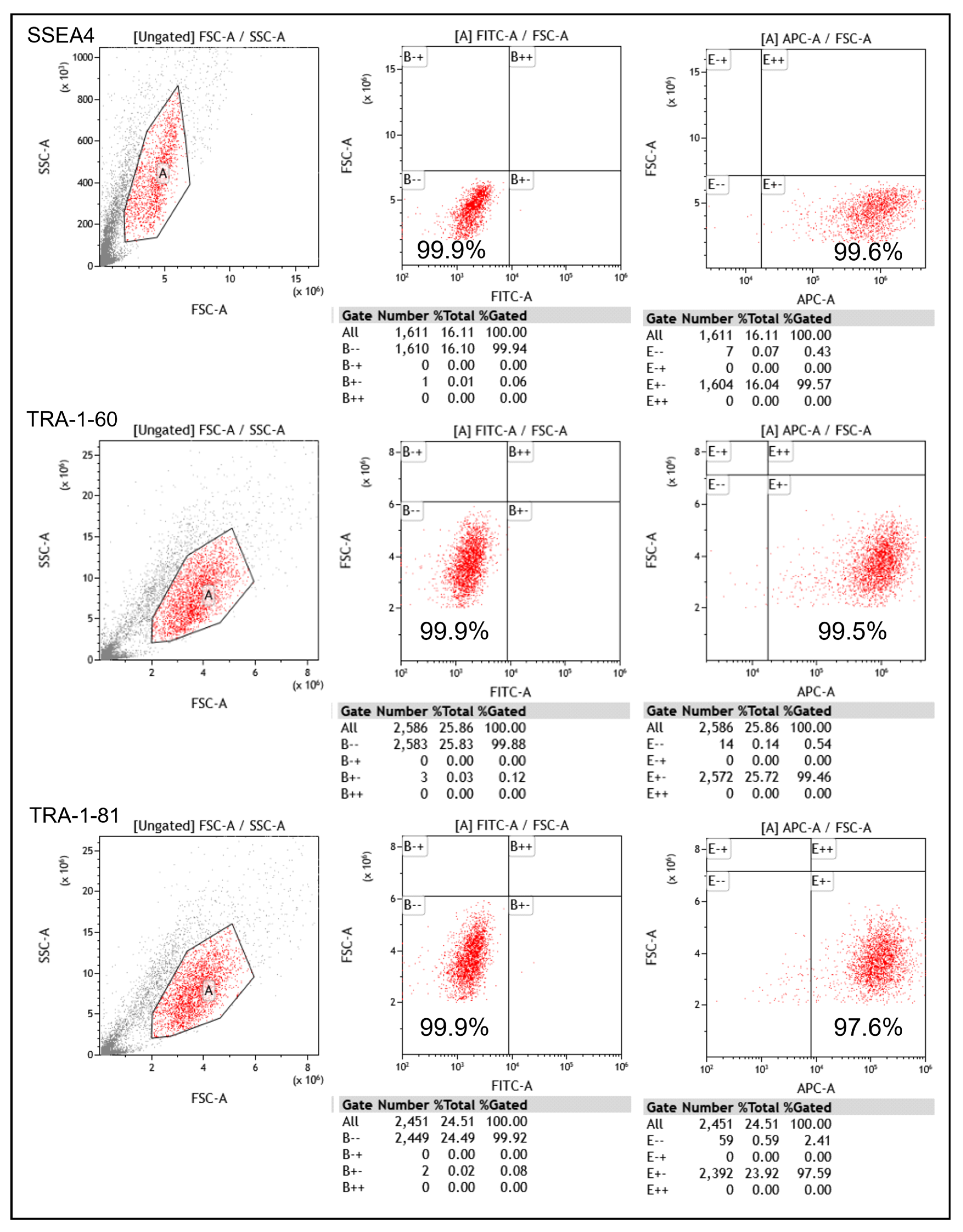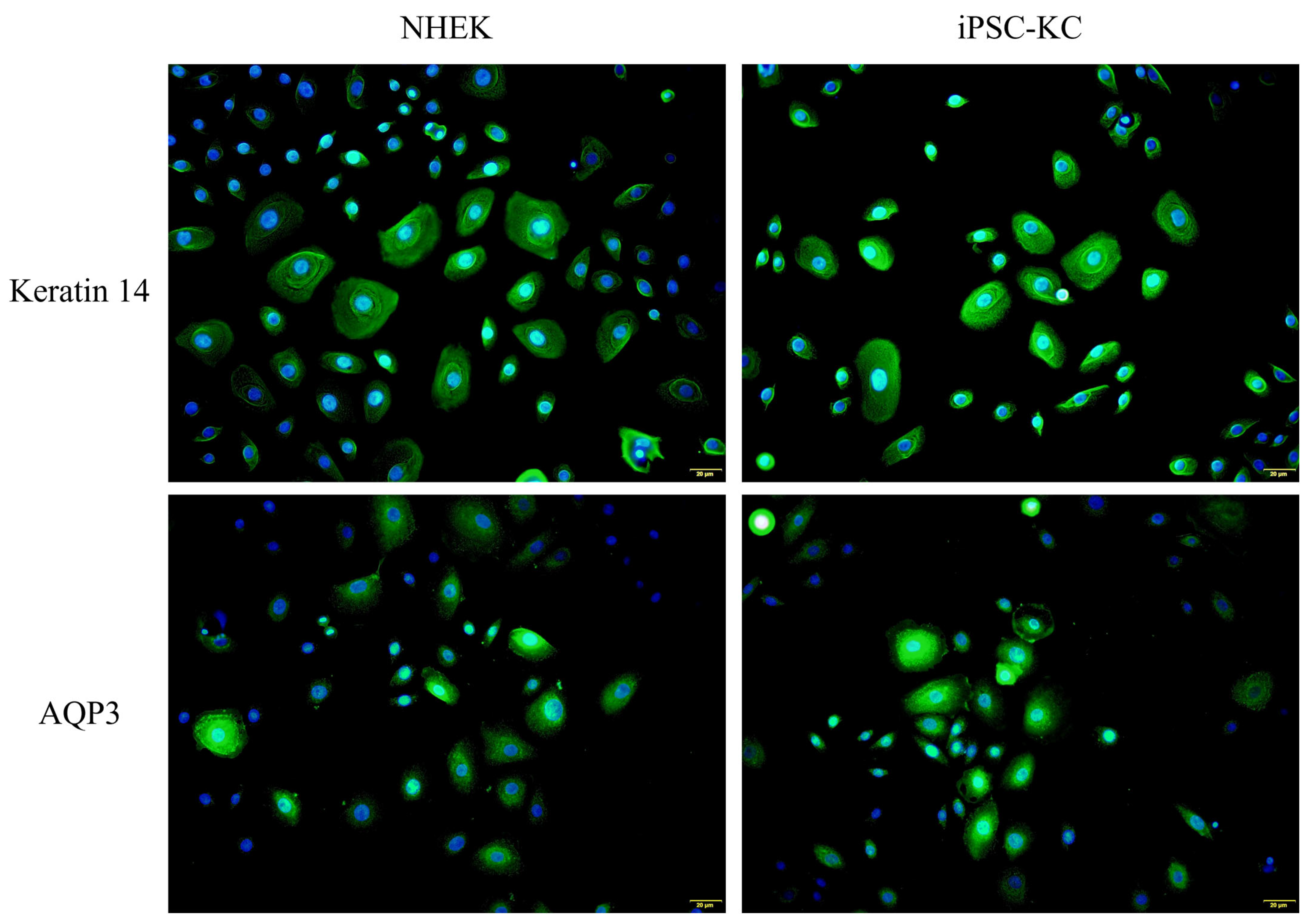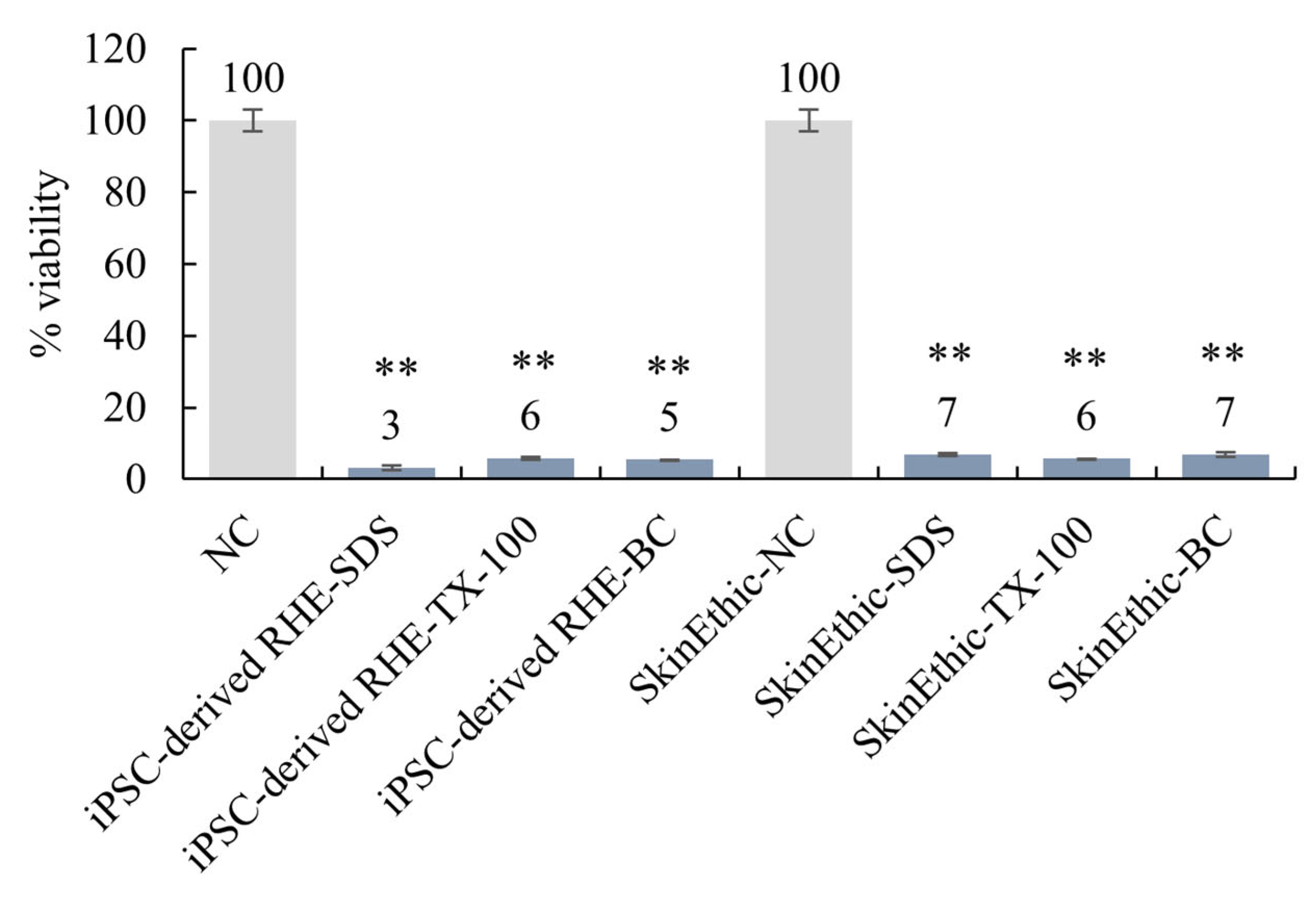Human Induced Pluripotent Stem Cells-Derived Reconstructed Epidermal Skin Model as an Alternative Model for Skin Irritation
Abstract
1. Introduction
2. Materials and Methods
2.1. Cell Culture
2.2. Generation of Human iPSCs
2.3. Differentiation of iPSCs into Keratinocytes
2.4. Reconstructed iPSC-Derived RHE and RHE
2.5. Quantitative Real-Time PCR Analysis
2.6. Immunohistofluorescence Assay
2.7. Skin Irritation Test
2.8. Statistical Analyses
3. Results
3.1. Induction of Human iPSCs from Fibroblasts
3.2. Differentiation from iPSCs into Keratinocytes
3.3. Reconstructed Epidermal Skin Model and Immunofluorescence Staining
3.4. Skin Irritation Tests
4. Discussion
5. Conclusions
Author Contributions
Funding
Institutional Review Board Statement
Informed Consent Statement
Data Availability Statement
Acknowledgments
Conflicts of Interest
References
- Stephens, M.L.; Goldberg, A.M.; Rowan, A.N. The first forty years of the alternatives approach: Refining, reducing, and replacing the use of laboratory animals. In The State of the Animals; Salem, D.J., Rowan, A.N., Eds.; Humane Society Press: Washington, DC, USA, 2001; pp. 121–135. [Google Scholar]
- Schmook, F.P.; Meingassner, J.G.; Billich, A. Comparison of human skin or epidermis models with human and animal skin in in-vitro percutaneous absorption. Int. J. Pharm. 2001, 215, 51–56. [Google Scholar] [CrossRef] [PubMed]
- Smits, J.P.; Niehues, H.; Rikken, G.; van Vlijmen-Willems, I.M.; van de Zande, G.W.; Zeeuwen, P.L.; Schalkwijk, J.; van den Bogaard, E.H. Immortalized N/TERT keratinocytes as an alternative cell source in 3D human epidermal models. Sci. Rep. 2017, 7, 11838. [Google Scholar] [CrossRef] [PubMed]
- Choi, M.; Lee, C. Immortalization of primary keratinocytes and its application to skin research. Biomol. Ther. 2015, 23, 391. [Google Scholar] [CrossRef] [PubMed]
- Strudwick, X.L.; Lang, D.L.; Smith, L.E.; Cowin, A.J. Combination of low calcium with Y-27632 rock inhibitor increases the proliferative capacity, expansion potential and lifespan of primary human keratinocytes while retaining their capacity to differentiate into stratified epidermis in a 3D skin model. PLoS ONE 2015, 10, e0123651. [Google Scholar] [CrossRef]
- Okita, K.; Ichisaka, T.; Yamanaka, S. Generation of germline-competent induced pluripotent stem cells. Nature 2007, 448, 313–317. [Google Scholar] [CrossRef]
- Takahashi, K.; Tanabe, K.; Ohnuki, M.; Narita, M.; Ichisaka, T.; Tomoda, K.; Yamanaka, S. Induction of pluripotent stem cells from adult human fibroblasts by defined factors. Cell 2007, 131, 861–872. [Google Scholar] [CrossRef]
- Zhong, H.; Ren, Z.; Wang, X.; Miao, K.; Ni, W.; Meng, Y.; Lu, L.; Wang, C.; Liu, W.; Deng, C.-X. Stagewise keratinocyte differentiation from human embryonic stem cells by defined signal transduction modulators. Int. J. Biol. Sci. 2020, 16, 1450. [Google Scholar] [CrossRef]
- Tchieu, J.; Zimmer, B.; Fattahi, F.; Amin, S.; Zeltner, N.; Chen, S.; Studer, L. A modular platform for differentiation of human PSCs into all major ectodermal lineages. Cell Stem Cell 2017, 21, 399–410.e397. [Google Scholar] [CrossRef]
- Li, A.; Simmons, P.J.; Kaur, P. Identification and isolation of candidate human keratinocyte stem cells based on cell surface phenotype. Proc. Natl. Acad. Sci. USA 1998, 95, 3902–3907. [Google Scholar] [CrossRef]
- Green, H.; Easley, K.; Iuchi, S. Marker succession during the development of keratinocytes from cultured human embryonic stem cells. Proc. Natl. Acad. Sci. USA 2003, 100, 15625–15630. [Google Scholar] [CrossRef]
- Zangrossi, S.; Marabese, M.; Broggini, M.; Giordano, R.; D’Erasmo, M.; Montelatici, E.; Intini, D.; Neri, A.; Pesce, M.; Rebulla, P. Oct-4 expression in adult human differentiated cells challenges its role as a pure stem cell marker. Stem Cells 2007, 25, 1675–1680. [Google Scholar] [CrossRef] [PubMed]
- Giorgetti, A.; Montserrat, N.; Aasen, T.; Gonzalez, F.; Rodríguez-Pizà, I.; Vassena, R.; Raya, A.; Boué, S.; Barrero, M.J.; Corbella, B.A. Generation of induced pluripotent stem cells from human cord blood using OCT4 and SOX2. Cell Stem Cell 2009, 5, 353–357. [Google Scholar] [CrossRef] [PubMed]
- Drews, K.; Matz, P.; Adjaye, J. Generation of iPSC lines from primary human amniotic fluid cells. Stem Cell Res. 2015, 15, 712–714. [Google Scholar] [CrossRef] [PubMed]
- Kuang, Y.-L.; Munoz, A.; Nalula, G.; Santostefano, K.E.; Sanghez, V.; Sanchez, G.; Terada, N.; Mattis, A.N.; Iacovino, M.; Iribarren, C. Evaluation of commonly used ectoderm markers in iPSC trilineage differentiation. Stem Cell Res. 2019, 37, 101434. [Google Scholar] [CrossRef] [PubMed]
- Zhang, X.; Yin, M.; Zhang, L.-J. Keratin 6, 16 and 17—Critical barrier alarmin molecules in skin wounds and psoriasis. Cells 2019, 8, 807. [Google Scholar] [CrossRef]
- Sougrat, R.; Gobin, R.; Verbavatz, J.-M.; Morand, M.; Gondran, C.; Barré, P.; Bonté, F.; Dumas, M. Functional expression of AQP3 in human skin epidermis and reconstructed epidermis. J. Investig. Dermatol. 2002, 118, 678–685. [Google Scholar] [CrossRef]
- Ghahary, A.; Marcoux, Y.; Karimi-Busheri, F.; Tredget, E.E. Keratinocyte differentiation inversely regulates the expression of involucrin and transforming growth factor β1. J. Cell. Biochem. 2001, 83, 239–248. [Google Scholar] [CrossRef]
- Schmidt, A.D. Understanding the Role of Involucrin in Skin Inflammation. Ph.D. Thesis, Washington University in St. Louis, St. Louis, MI, USA, 2022. [Google Scholar]
- Kim, Y.; Lim, K.-M. Skin barrier dysfunction and filaggrin. Arch. Pharmacal Res. 2021, 44, 36–48. [Google Scholar] [CrossRef]
- Kezic, S.; Jakasa, I. Filaggrin and skin barrier function. Ski. Barrier Funct. 2016, 49, 1–7. [Google Scholar]
- Itoh, A.; Tsujikawa, T.; Fujiyama, Y.; Bamba, T. Enhancement of aquaporin-3 by vasoactive intestinal polypeptide in a human colonic epithelial cell line. J. Gastroenterol. Hepatol. 2003, 18, 203–210. [Google Scholar] [CrossRef]
- Kezic, S.; Kemperman, P.M.; Koster, E.S.; de Jongh, C.M.; Thio, H.B.; Campbell, L.E.; Irvine, A.D.; McLean, W.I.; Puppels, G.J.; Caspers, P.J. Loss-of-function mutations in the filaggrin gene lead to reduced level of natural moisturizing factor in the stratum corneum. J. Investig. Dermatol. 2008, 128, 2117–2119. [Google Scholar] [CrossRef] [PubMed]
- Dubau, M.; Tripetchr, T.; Mahmoud, L.; Kral, V.; Kleuser, B. Advancing skin model development: A focus on a self-assembled, induced pluripotent stem cell-derived, xeno-free approach. J. Tissue Eng. 2024, 15, 20417314241291848. [Google Scholar] [CrossRef] [PubMed]
- Andres, E.; Barry, M.; Hundt, A.; Dini, C.; Corsini, E.; Gibbs, S.; Roggen, E.; Ferret, P.J. Preliminary performance data of the RHE/IL-18 assay performed on SkinEthic™ RHE for the identification of contact sensitizers. Int. J. Cosmet. Sci. 2017, 39, 121–132. [Google Scholar] [CrossRef] [PubMed]
- Qiao, W.; Xie, T.; Lu, J.; Jia, T.; Kaku, K. Identification of potential hub genes associated with atopic dermatitis-like recombinant human epidermal model using integrated transcriptomic and proteomic analysis. Biomol. Biomed. 2024, 24, 89. [Google Scholar] [CrossRef]
- Guideline, P.-B.T. OECD guideline for the testing of chemicals. Hershberger 2001, 601, 858. [Google Scholar]
- Sah, S.K.; Kanaujiya, J.K.; Chen, I.-P.; Reichenberger, E.J. Generation of keratinocytes from human induced pluripotent stem cells under defined culture conditions. Cell. Reprogramming 2021, 23, 1–13. [Google Scholar] [CrossRef]
- Visscher, M.O.; Carr, A.N.; Winget, J.; Huggins, T.; Bascom, C.C.; Isfort, R.; Lammers, K.; Narendran, V. Biomarkers of neonatal skin barrier adaptation reveal substantial differences compared to adult skin. Pediatr. Res. 2021, 89, 1208–1215. [Google Scholar] [CrossRef]
- Ågren, J.; Zelenin, S.; Håkansson, M.; Eklöf, A.-C.; Aperia, A.; Nejsum, L.N.; Nielsen, S.; Sedin, G. Transepidermal water loss in developing rats: Role of aquaporins in the immature skin. Pediatr. Res. 2003, 53, 558–565. [Google Scholar] [CrossRef]






| Primer Sequences | Primer Name |
|---|---|
| CTTGAATCCCGAATGGAAAGGG | OCT4-F |
| GTGTATATCCCAGGGTGATCCTC | OCT4-R |
| GCCGAGTGGAAACTTTTGTCG | SOX2-F |
| GGCAGCGTGTACTTATCCTTCT | SOX2-R |
| CCCACATGAAGCGACTTCCC | KLF4-F |
| CAGGTCCAGGAGATCGTTGAA | KLF4-R |
| ATGGCCCATTACAAAGCCG | c-MYC-F |
| TTTCTGGAGTAGCAGCTCCTAA | c-MYC-R |
| TTTGTGGGCCTGAAGAAAACT | NANOG-F |
| AGGGCTGTCCTGAATAAGCAG | NANOG-R |
| GTGTTCAGCCAAAAGACCATCT | POU5F1-F |
| GGCCTGCATGAGGGTTTCT | POU5F1-R |
| AGTGAAGAGATGCACGGATCA | CGB-F |
| CACCAGGACTTCCGCAATGA | CGB-R |
| ATGTCTGTTCGATACAGCTCAAG | KRT10-F |
| CTCCACCAAGGGAGCCTTTG | KRT10-R |
| TGAGCCGCATTCTGAACGAG | KRT14-F |
| GATGACTGCGATCCAGAGGA | KRT14-R |
| GGACCAGCAGATTCAGAACGG | TP63-F |
| AGGACACGTCGAAACTGTGC | TP63-R |
| CCTGCCGATAACTATCATCTGGC | TBP-F |
| GTTTCCACGGATGCTTTCTCG | TBP-R |
| TGAAGCCTATGACACCACTGA | FLG-F |
| TCCCCTACGCTTTCTTGTCCT | FLG-R |
| GGGGAGATGCTCCACATCC | AQP3-F |
| AAAGGCCAGGTTGATGGTGAG | AQP3-R |
| CCTCCTGGGAGTGATAGCAAT | CLDN1-F |
| GGCAACTAAAATAGCCAGACCT | CLDN1-R |
| TCCTCCAGTCAATACCCATCAG | IVL-F |
| CAGCAGTCATGTGCTTTTCCT | IVL-R |
| CCAAGGTTGATGCACTGATGG | KRT5-F |
| TGTCAGAGACATGCGTCTGC | KRT5-R |
| ATGTCTGTTCGATACAGCTCAAG | KRT10-F |
| CTCCACCAAGGGAGCCTTTG | KRT10-R |
| ATGTTCGCCATGAAAACTAAGGC | TSLP-F |
| GCGACGCCACAATCCTTGTA | TSLP-R |
| ACTCACCTCTTCAGAACGAATTG | IL-6-F |
| CCATCTTTGGAAGGTTCAGGTTG | IL-6-R |
| ACTGAGAGTGATTGAGAGTGGAC | IL-8-F |
| AACCCTCTGCACCCAGTTTTC | IL-8-R |
| AGGACGACTGTTCAGCACG | TNF-a |
| CCGGGCAACAATGTCCAAAAG | TNF-a |
| GGAGCGAGATCCCTCCAAAAT | GAPDH-F |
| GGCTGTTGTCATACTTCTCATGG | GAPDH-R |
Disclaimer/Publisher’s Note: The statements, opinions and data contained in all publications are solely those of the individual author(s) and contributor(s) and not of MDPI and/or the editor(s). MDPI and/or the editor(s) disclaim responsibility for any injury to people or property resulting from any ideas, methods, instructions or products referred to in the content. |
© 2025 by the authors. Licensee MDPI, Basel, Switzerland. This article is an open access article distributed under the terms and conditions of the Creative Commons Attribution (CC BY) license (https://creativecommons.org/licenses/by/4.0/).
Share and Cite
Xie, T.; Qiao, W.; Jia, T.; Kaku, K. Human Induced Pluripotent Stem Cells-Derived Reconstructed Epidermal Skin Model as an Alternative Model for Skin Irritation. Cosmetics 2025, 12, 75. https://doi.org/10.3390/cosmetics12020075
Xie T, Qiao W, Jia T, Kaku K. Human Induced Pluripotent Stem Cells-Derived Reconstructed Epidermal Skin Model as an Alternative Model for Skin Irritation. Cosmetics. 2025; 12(2):75. https://doi.org/10.3390/cosmetics12020075
Chicago/Turabian StyleXie, Tong, Wu Qiao, Tinghan Jia, and Ken Kaku. 2025. "Human Induced Pluripotent Stem Cells-Derived Reconstructed Epidermal Skin Model as an Alternative Model for Skin Irritation" Cosmetics 12, no. 2: 75. https://doi.org/10.3390/cosmetics12020075
APA StyleXie, T., Qiao, W., Jia, T., & Kaku, K. (2025). Human Induced Pluripotent Stem Cells-Derived Reconstructed Epidermal Skin Model as an Alternative Model for Skin Irritation. Cosmetics, 12(2), 75. https://doi.org/10.3390/cosmetics12020075





